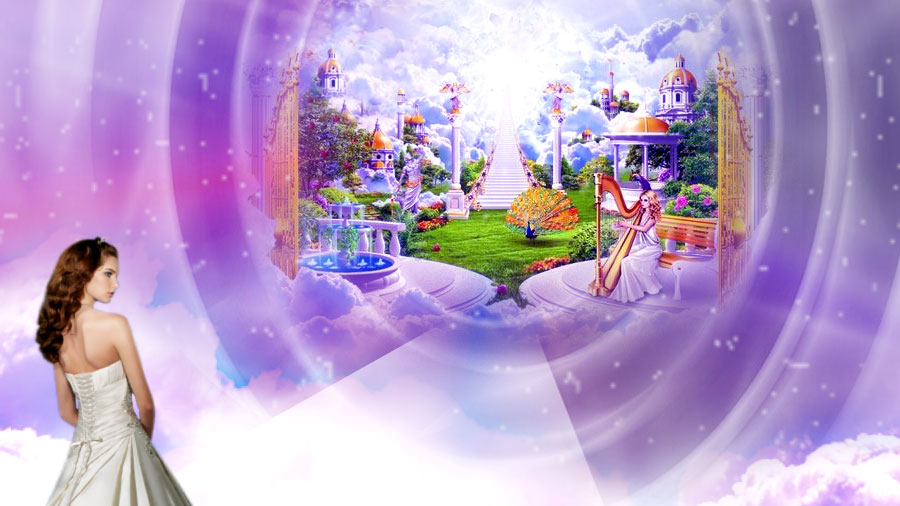The World In The Afterlife
 by Stafford Betty
by Stafford Betty
The World in the Afterlife According to Consistent Reports by Spiritualistic Mediums
1. The Afterworld is not some fantastic vision of infinity where souls are locked in poses of permanent rapture gazing at the face of God. And no one floats on a cloud, while playing a harp. Rather it is a place with landscapes and seas and houses and cities reminiscent of our own world—a material world, but of higher vibration insensible to us earthlings. There are gardens, universities, libraries, and hospices for the newly dead—but no factories, fire stations, sanitary landfills, or smokestacks. There are no dirty jobs to do. “We have no traffic, and our roads are covered with the thickest and greenest grass, as soft to the feet as a bed of fresh moss. It is on these that we walk,” says Msgr. Hugh Benson. All accounts describe a world of exquisite natural beauty.
2. The Afterworld begins at the earth’s surface and extends outward. Earth is [just one] nucleus of the world system that the spirits describe. “The spirit world begins very near the earth and extends millions of miles beyond,” writes Leslie Stringfellow. It “surrounds yours on all sides, like the atmosphere does the globe, and every nation has its counterpart in spirit, surrounding it, in connection with that part over or nearest its earthly place of residence.”
3. Spirits do not usually refer to their world as heaven. Their world is actually a spectrum of realms stretching from the lowly joys and satisfactions of a novice soul just come over; to spheres of unimaginable radiance, perfection, and fulfillment that they have only heard about or at best visited; to darker, murkier regions where souls of a lower order reside.
4. The newly “dead” are thoroughly themselves when they pass. Their personalities and habits and character, for better or worse, are completely intact. Spirits are not omniscient. They don’t get the answers to all the questions that puzzled them back on earth just because they’ve died. Many fail to grasp their condition; some, especially those who were certain that death meant extinction, even refuse to believe they have died. For, as we have seen, the landscapes of the astral world are similar to the landscapes of earth they left behind.
5. Though they are recognizably themselves, life in the astral is more vivid and intense than on earth, not more ghostly. Astral beings have fewer limitations. They can communicate telepathically and with much greater precision than through the cumbersome medium of speech. They can move from place to place by willing to be at their destination, though they can walk if they want to. Their minds are sharper, their emotions more acutely felt, both positive and negative. They see and hear as before, but in a more intense way. The old bodies they left behind do not follow them beyond death. Spirits are not naked, but clothed. Astral clothing is fashioned by the mind. There are no clothes closets in the astral.
6. The Afterworld is a broad-based society of every conceivable kind of person, most of them flawed and incomplete in some way or another. Many are no more motivated to “grow their souls” than they were back on earth. According to Judge Patterson-Hatch, “Most are content to assimilate the experiences they had on earth . . . most souls do not demand enough here, any more than they did in life.” But the best are determined to advance.
7. Spirits are not allowed to overreach in the astral, but must grow in wisdom and in love gradually. They cannot enter a vibration or cross a boundary they are not ready for. There is justice in where they end up at death. There is definitely a law of karma. They gravitate to their rightful place. They can move ahead only when they are changed enough to do so. Benson tells us, “Each sphere is completely invisible to the inhabitants of the spheres below it, and in this respect, at least, it provides its own boundary.”
8. Many of them had ambitious plans for self-improvement before they descended into flesh, but the density of earth’s matter, including their own dense brain, caused them to forget what they came for. Subject to material concepts, they lost their way. They died only to discover to their disappointment that they mostly failed to accomplish the goal they had set for themselves. But for many of them it’s OK, for there has been much growth in unpremeditated ways.
9. The astral world provides opportunities for every wholesome interest or avocation – from science to music to theology to astral architecture to home building. It is a joyful, endlessly fascinating place, full of challenges, for those who desire to grow.
10. Physical danger does not exist in the astral. Neither does physical illness. Eating is optional and sleep unnecessary. The calls of nature do not get even a mention.
11. Many astral inhabitants maintain a lively interest in the events of earth and long to help it progress. They claim that many or even most of earth’s most brilliant achievements were inspired by spirits telepathically projecting their ideas. Nor do “the dead” forget their loved ones, whom they often seek to help with what we might call prayer in reverse.
12. Spirits do not meet an embodied personal God in the astral world. Instead many find themselves surrounded by an all-pervasive, penetrating Divine Light, full of understanding and love. This Light does not judge them, at least from the outside. They seem to judge themselves. As spirits advance, they move ever closer to the heart of the Creator.
13. They celebrate the presence of that Light in powerful rituals involving supremely grand music and displays of light, described in astonishing language. Music seems to be the supreme art of the astral, with most communicators noting its inspirational quality. According to Benson sound and light are coextensive: the astral is synesthetic. Painting, dance, theater, and architecture are also prominently mentioned. It is safe to say that the more refined a person’s aesthetic taste is in this life, the more at home he or she will feel in the higher realms of the astral.
14. There are hellish regions in the astral, and large populations that make their home there. What is sometimes referred to as the Shadow Lands is a vast world of many conditions. The landscapes vary from sordid city neighborhoods to parched, gray scrub land, to dark, lifeless deserts. The vivid clarity of higher realms is missing. Instead there is a dull overcast. Temporarily lost or confused or stubbornly unrepentant souls populate these regions. The Universe doesn’t curtsy to bad behavior.
15. Missionary spirits minister to souls in the Shadow Lands. Residents can free themselves if they are willing to face up humbly to their errors and crimes and repent them. Some do; and most, perhaps all, will eventually. But many jeer at their would-be helpers and seem to prefer their dull lives over the challenges of higher worlds they are frightened of.
16. Some spirits tell us that no spirit remains forever in the dark regions. But God will never interfere with our free will. S/He will invite tirelessly, but will never force.
17. There are three basic ways to progress in the Afterworld: admitting defects in one’s character, service to others, and yearning for higher states. Service to others demands effort, work, and sacrifice. Nowhere do the spirits describe a deity who requires us to flatter or glorify him with our prayers. That is not the way to progress.
18. There are no rigid creeds or magical beliefs that souls have to accept. Whether you are a Baptist or a Catholic or a Mormon or a Hindu or a Buddhist or a Muslim or an Anglican is of no importance. Many of earth’s favorite religious dogmas are off the mark anyway, and the sooner they are recognized as such, the better.
19. There are no masks in the astral. You cannot hide from others what you are: the quality of light shining forth from your body tells all. Mattson tells us that our negative thoughts “go around like big, heavy, sluggish pieces of material — like mud or oil slicks.” Even the house a spirit lives in reflects his spiritual stature. These facts can be humiliating at first, but it spurs spirits on to a greater effort to improve themselves.
20. Many accounts say that reincarnation is one of the keys to soul growth and is therefore crucial to the divine plan.
21. The Creator places souls in the difficult environment of earth because He (She) loves them. He wants to see them grow in wisdom, love, and power. He knows that the only way to bring out the best in a soul is to challenge it, in the same way that a good teacher challenges her students. Soul building, or character development, is the whole point of our sojourn, both on earth and beyond. The use we make of our free will is absolutely crucial to our progress at all levels.
Excerpt from Afterlife: The Evidence
Posted in Life After Death, Life On The Other Side, Spiritualitywith comments disabled.





